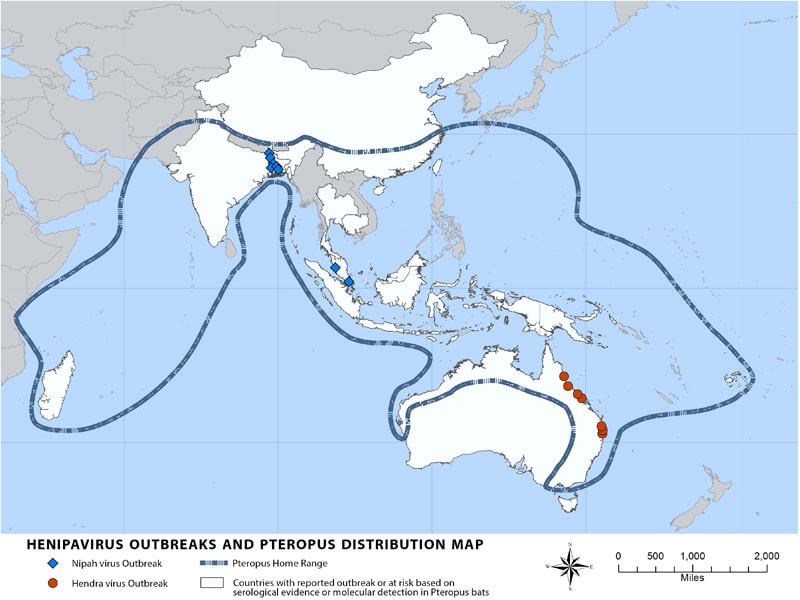
New on the MedlinePlus Hemorrhagic Fevers page:
05/29/2018 11:32 AM EDT
Source: Centers for Disease Control and Prevention
Nipah virus (NiV) is a member of the family Paramyxoviridae, genus Henipavirus. NiV was initially isolated and identified in 1999 during an outbreak of encephalitis and respiratory illness among pig farmers and people with close contact with pigs in Malaysia and Singapore. Its name originated from Sungai Nipah, a village in the Malaysian Peninsula where pig farmers became ill with encephalitis. Given the relatedness of NiV to Hendra virus, bat species were quickly singled out for investigation and flying foxes of the genus Pteropus were subsequently identified as the reservoir for NiV (Distribution Map).
In the 1999 outbreak, Nipah virus caused a relatively mild disease in pigs, but nearly 300 human cases with over 100 deaths were reported. In order to stop the outbreak, more than a million pigs were euthanized, causing tremendous trade loss for Malaysia. Since this outbreak, no subsequent cases (in neither swine nor human) have been reported in either Malaysia or Singapore.
In 2001, NiV was again identified as the causative agent in an outbreak of human disease occurring in Bangladesh. Genetic sequencing confirmed this virus as Nipah virus, but a strain different from the one identified in 1999. In the same year, another outbreak was identified retrospectively in Siliguri, India with reports of person-to-person transmission in hospital settings (nosocomial transmission). Unlike the Malaysian NiV outbreak, outbreaks occur almost annually in Bangladesh and have been reported several times in India.
MEDICAL ENCYCLOPEDIA
National Institutes of Health
Other Languages
Viral hemorrhagic fevers (VHFs) are a group of illnesses caused by four families of viruses. These include the Ebola and Marburg, Lassa fever, and yellow fever viruses. VHFs have common features: they affect many organs, they damage the blood vessels, and they affect the body's ability to regulate itself. Some VHFs cause mild disease, but some, like Ebola or Marburg, cause severe disease and death.
VHFs are found around the world. Specific diseases are usually limited to areas where the animals that carry them live. For example, Lassa fever is limited to rural areas of West Africa where rats and mice carry the virus.
The risk for travelers is low, but you should avoid visiting areas where there are disease outbreaks. Because there are no effective treatments for some of these viral infections, there is concern about their use in bioterrorism.
Centers for Disease Control and Prevention
- Need yellow fever vaccine? Plan ahead (03/27/2018, Centers for Disease Control and Prevention)
- Travelers' Health: Yellow Fever (Centers for Disease Control and Prevention)
- Arenaviridae (Centers for Disease Control and Prevention)
- Crimean-Congo Haemorrhagic Fever (World Health Organization)Also in Spanish
- Crimean-Congo Hemorrhagic Fever (CCHF) (Centers for Disease Control and Prevention)
- Filoviridae (Centers for Disease Control and Prevention)
- Hemorrhagic Fever with Renal Syndrome (HFRS) (Centers for Disease Control and Prevention)
- Lassa Fever (Centers for Disease Control and Prevention)
- Marburg Hemorrhagic Fever (Marburg HF) (Centers for Disease Control and Prevention)
- Marburg Virus Disease (World Health Organization)
- Need yellow fever vaccine? Plan ahead (Centers for Disease Control and Prevention)Also in Spanish
 Nipah Virus (NiV) (Centers for Disease Control and Prevention)
Nipah Virus (NiV) (Centers for Disease Control and Prevention)- Rift Valley Fever (RVF) (Centers for Disease Control and Prevention)
- Yellow Fever (Centers for Disease Control and Prevention)
- ClinicalTrials.gov: Hemorrhagic Fevers, Viral
 (National Institutes of Health)
(National Institutes of Health) - ClinicalTrials.gov: Yellow Fever
 (National Institutes of Health)
(National Institutes of Health)
- Yellow fever (Medical Encyclopedia)Also in Spanish
- Yellow Fever Vaccine: What You Need to Know (Centers for Disease Control and Prevention) - PDFAlso in Spanish






















.png)











No hay comentarios:
Publicar un comentario